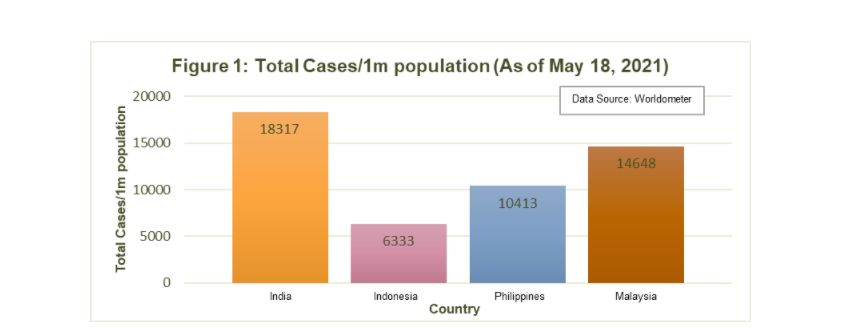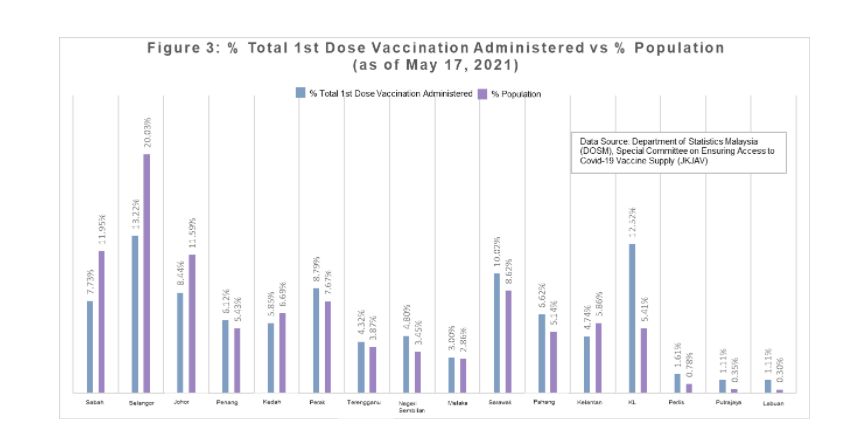Although the current administration plans to utilise a total of RM5 billion from the National Trust Fund (KWAN) to expedite the purchase of Covid-19 vaccines, limited supplies in the global vaccination distribution chain might hinder Malaysia’s progress in achieving herd immunity by the end of this year.
According to National Immunisation Programme (NIP) Coordinating Minister Khairy Jamaluddin, only 42.20 per cent of the population (10,232,913 individuals) had registered for vaccination as of Monday (May 17). It is still far from the country’s desired target — to inoculate more than 80 per cent of the population (nearly 27 million out of 32 million Malaysians) by the end of this year.
With limited vaccine supplies across the globe, there is an increasing concern that Malaysia will not be able to kickstart Phase Three of the NIP as scheduled, and will not be able to cope with the rising number of Covid-19 cases in the country.
To date, Phase Three of the vaccination will involve 13.7 million people, whereby both citizens and non-citizens aged 18 years and above will be eligible for vaccination. It is scheduled to run from May 2021 to February 2022.
However, many developed nations have acted out in their own self-interest. Several wealthy countries acquired more doses than required to inoculate their entire population, causing a slower vaccination rollout in developing countries like Malaysia.
According to the World Health Organization (WHO), one in four people in the developed world has received at least one dose of vaccine, compared with one in 500 for low-income nations.
As of February 2021, the European Union (EU) has ordered 1.6 billion doses for its adult population of roughly 375 million, whereas the UK ordered 219 million complete vaccinations for its 54 million adults.
It is a worrying scenario as Malaysia has reported over 2,000 daily new Covid-19 cases for three weeks since April 15. As of May 18, the total Covid-19 cases per one million population in Malaysia (14,648 cases) has exceeded neighbouring Southeast Asian countries like Indonesia (6,333) and the Philippines (10,413).
Although India’s population (1.391 billion) is 43 times larger than Malaysia (32 million), the total Covid-19 cases per one million population in India only consists of 18,317 cases, as shown in Figure 1.

Despite the NIP outlining the usage of mobile vaccination clinics, the majority of sites are still concentrated within urban areas along the west coast of Peninsular Malaysia. This can be seen when Sabah and Sarawak registered low vaccination rates as of May 17, which are 2.44 per cent and 4.38 per cent respectively, as shown in Figure 2.

Figure 3 shows the total percentage of the population that have received their first dose as of May 17, further revealing different vaccination coverage levels across all Malaysian states.

Among the states with larger population sizes such as Selangor, the number of people who received at least their first dose as a proportion of the total number vaccinated with at least the first dose nationwide is the lowest at 13.22 per cent. Population wise, 20.03 per cent of Malaysians reside in Selangor. This coincides with a low vaccination rate of 2.49 per cent, as shown in Figure 2.
In contrast, remaining states with smaller population sizes such as Penang, Perak, Terengganu, Negeri Sembilan, Melaka, Pahang, Kuala Lumpur, Perlis, Putrajaya and Labuan had a higher percentage of first-dose vaccination administered compared to their population.
This is particularly obvious in Labuan where the number of people receiving at least the first dose over the total vaccinated with at least the first dose nationwide is 1.11 per cent. But only 0.30 per cent of Malaysians reside in Labuan, which gives it a high vaccination rate of 13.69 per cent.
To summarise, both Figures 2 and 3 illustrate that it is relatively easy for the states with smaller population sizes to mobilise vaccine corps to volunteer in the vaccination programme.
Vaccine corps refer to health care workers who can deliver vaccine shots, monitor individuals who had just been vaccinated, and schedule second doses for the vaccines to be fully effective.
On the other hand, states with larger population sizes would have to mobilise a large number of volunteers for the vaccine corps, in addition to problems associated with trying to reach rural communities which live beyond 5 km of any kind of health care facility. A lack of specialists and medical equipment can also hinder the progress of vaccination.
As of May 17, only 12.47 per cent (1,234,630 individuals) out of a targeted 9.9 million nationwide has received at least their first dose of the Covid-19 vaccine during Phases One and Two. With the recent rise of Covid-19 cases in the country, there is an increasing concern that the vaccination coverage remains low in some states such as Sabah, Selangor, Johor, Kedah, Sarawak and Kelantan.
Although it is a good sign that 268,000 people in Kuala Lumpur and Selangor have registered their interest for the AstraZeneca opt-in vaccine programme on May 2, the current administration might face challenges to inoculate more individuals outside the Klang Valley during the coming weeks.
The NIP handbook has indicated a relatively low number of Vaccine Administration Centres (VACs) allocated for states such as Kelantan, Terengganu, Pahang, Johor, Sabah and Sarawak.
As mentioned in my previous article, Vaccination Coverage: A Crucial Factor in Achieving Herd Immunity in Malaysia, the Special Committee on Covid-19 Vaccine Supply (JKJAV) should look into several policy recommendations by EMIR Research, enhancing vaccination coverage in all Malaysian states during this year:
- Enhance coordination between the federal government and state governments to ensure the vaccines are distributed according to population needs and logistical requirements;
- Mobilise a large number of volunteers for the vaccine corps. Besides medical, nursing and pharmacy students, vaccine corps can comprise members of the community, including retired or unemployed clinicians;
- Allocate more vaccines to areas identified as red or orange zones. Red zones are areas with more than 41 confirmed Covid-19 cases, whereas orange zones are areas which have between 21 to 40 cases. For instance, the current administration can allocate more vaccines in seriously infected states such as Selangor, Johor, KL, Sarawak and Kelantan; and
- Mark and include all the semi-urban, rural and interior areas, ensuring an effective house-to-house community outreach programme that can be implemented by the National Disaster Management Agency (NADMA) with the involvement of the military. This would ensure citizens in these areas will receive vaccination as soon as possible.
As suggested by the People’s Health Forum (PHF) on Is Vaccination Against Covid-19 Really Necessary?, a mass vaccination programme would help Malaysia to achieve herd immunity as scheduled. A lower R-naught value (below 1.0) would also enable Malaysia to gauge the right balance between lives and livelihoods, protecting citizens from ideadly epidemics.
In a nutshell, it is crucial for the government to constantly monitor the vaccination coverage across all Malaysian states, in order to give Malaysians the chance to enjoy normalcy again and help the economy recover gradually.
Amanda Yeo is a research analyst at EMIR Research, an independent think tank focused on strategic policy recommendations based on rigorous research.
- This is the personal opinion of the writer or publication and does not necessarily represent the views of CodeBlue.






